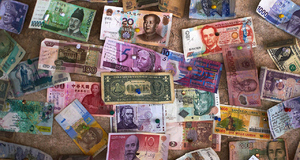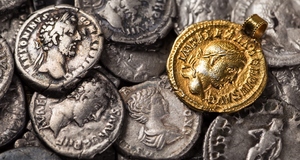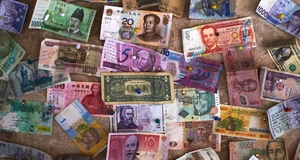Contrasting Views of Money in Ayn Rand's Atlas Shrugged
By
2009, Vol. 1 No. 12 | pg. 1/1
KEYWORDS:
Atlas Shrugged’s presentation of money departs from the traditional dichotomy of the “haves and have-nots.” In fact such a characterization of money succinctly captures the ultimate evil, in conflict with the ultimate good. The separation it insists on instead may be called “the makers and the maker-nots.” The latter comprises both the haves and the have-nots, while the makers are the golden examples of the good, whose every cent was earned through their own effort. These, the makers, the builders, the achievers, hold the belief that “the words ‘to make money’ hold the essence of human morality” (384). Any point of discussion on the difference between the heroes and villains is a variation on a theme: to the heroes money has important and specific meaning, while to the villains money has no particular meaning that they can or are willing to imagine. For the heroes it is simple: the process of working, as a manifestation of one’s spirit, is sacred; and accordingly one’s money, as the eventual product of such, is sacred. There is no inherent corrupting quality to money, as Francisco d’Anconia says in his speech to Jim Taggart’s wedding crowd, “Money is made—before it can be looted or mooched—made by the effort of every honest man, each to the extent of his ability…” (381). If each person shared this divine appreciation of work, each person could obtain money proportional to the expression of his or her own spirit. Meanwhile the villains achieve a state of insensitivity to money through indoctrinated short-term memory loss. The men in Washington will not hear of “absolute standards,” but only “the reality of the day” (337). The present second becomes the only frame of reference; as John Galt explains over the radio, the villains thus attempt to divorce money from its origins (950). This implies the rejection of a rational universe, in which one event causes a later event to occur. The concept of “making” profit, which describes movement through time, becomes virtually indiscernible from that of “having” profit, which describes a static state without cause or purpose—“as if wealth, the effect, could give you ability, the cause” (950).For villainous wealth is obtained within these premises not by ability, but by cheating. The cheating methodology in Atlas Shrugged has villains living a sort of double-life, exemplified by using euphemisms like “public equality” in defense of laziness and incompetence. Describing the infamous Twentieth Century Motors experiment, the vagabond Jeff Allen admits that every person in the room, in his or her heart, understood the true implications of the plan; yet they went along as if they bought into its philosophy because they figured it would be easier to take advantage of the system than to actually earn their money (614). Further a doctrine of “essential need” allows people to believe that some need is not readily satisfied by ability. Thus wanting to make money—a desire attainable through action—is replaced by needing to have money, a more pressing desire justifying any means. Under this system, one can publicly denounce the money of others as a selfish indulgence, then privately scheme for a way to loot it, as the Mexican government intended to do with d’Anconia Cooper’s San Sebastian mines (73). The ultimate goal is for such behavior to become normalized, and for people to stop distinguishing between money obtained justly and money obtained by fraud. Thus follows a situation in which each person feigns lack of understanding and responsibility proportional to his or her sin; accordingly successful swindling comes to be redefined as virtue. Jim Taggart offers this most revealing outburst: “…how do you think he [Bertram Scudder] got to where he was, except by climbing on carcasses?” (799) If everyone refuses to conceive of honest profit, no one need acknowledge guilt for cheating to have money. It is a grand deception in which no one is actually deceived. Yet for such a scheme to function properly, full participation is necessary, and the heroes, naturally, refuse to “play the game.” When the government attempts to force Rearden, under the pretense of courtesy, to surrender his metal to them, he responds “You need my help to make it look like a sale—like a safe, moral transaction. I will not help you” (341). Like the other heroes, he will not recognize as legitimate money not obtained by open exchange, through fair avenues. Hence they believe in an “aristocracy of money.” They do not abide by a system of family names or social customs; their community simply describes any great industrialists, philosophers, artists and the like, who earned their wealth by exercising the strength of their own individual minds. Kinetic greatness is the only path to the realm of the aristocracy of money; as Francisco, the heir of an old family copper mining firm, says as a young man, “none of us has ever been permitted to think he is born a d’Anconia. We are expected to become one” (89). Since no one need depend on another for connections, each individual is in control of his or her own life, and therefore in control of his or her own money. Thus follows an important distinction: the heroes, as Dagny Taggart observes of Midas Mulligan, are characterized by “the wealth of selection” (675), or spending hard-earned money in ways meant solely for one’s own selfish pleasures. As Dagny muses, “there was no meaning in motors or factories or trains… their only meaning was in man’s enjoyment of his life, which they served…” (670) With this attitude, money is a tool to be worshipped only to the extent to which one worships oneself, and thus material possessions are always in balance with the mind that creates them and gives them meaning. The villains, however, are incapable of assigning money any meaning, having invested no personal exertion in its acquisition, and so they instead allow it to dominate them. Their quest to “have” money is not self-actualizing, but self-destructive, as they fall into “the wealth of accumulation” (675). In Rearden’s words they are “in awe” of their own possessions, “as if their dining room were the master and they were just objects serving it… not the other way around” (345). They spend money in order to impress others, as if to say to others, look what I have, rather than to say to themselves, this is what I have made. While the villains “need” their money to maintain social status, that they do not know how to properly handle or define it simultaneously renders it a social taboo, as opposed to a source of pride and enjoyment. This is in accordance with their prescription to “the aristocracy of pull,” which involves a nobility mentality of social webs and outdated customs exemplified by the men in Washington. But the aristocracy of pull encapsulates not only “haves,” but “have-nots” as well. The businessman Lee Hansacker, whose “family once belonged to the New York Four Hundred” (292), represents the failures of the community. Littering Hansacker’s bitter speech are words like “entitlement” and “birthright”—things he believes should have assured him financial success, before he even offered up any of his own energy. Hansacker is possessed by a sort of untrue greed, meaning his motivations for wanting money, as with other villains, are not easy to initially perceive. The heroes practice pure greed—they seek to make money as an actualization of their potential. During their search for the inventor of the motor, Dagny studies Rearden’s features and observes that achievement worthy of admiration stems from “a face stripped of everything but purpose” (350). Herein lies the key to happiness: money buys happiness, because money is the product of work, which spurs progress—which ultimately denotes purpose, the essence of being. Therefore making money is not only a way of life, but is indicative of life. A hero is a happy person because he or she is imbued with individual purpose, signifying love of self, work, life, and money. The heroes’ desire to make money may then be said to be motivated by love. The desire to have money, however, does not stem from a desire of money, but a desire to have something—that is, specifically to stand still and to force everything else to do likewise. This is manifested in the villains’ attempt to hold power over the heroes. The husband-wife relationship of Hank and Lillian Rearden most effectively demonstrates this dynamic: Lillian regards her husband as a great race horse who must be bridled down “because if you let the horse go full blast, it would throw you off in no time…” (371) The villains, then, do not actually care about money. They are devoid of purpose, of that purity of greed which graces the heroes. As such they cannot bear movement or progress. Motivated, as Jim discovers, by hatred, “hatred as the soul reality, hatred without cause, beginning or end” (575), the villains seek to create an infinite moment of stagnant “having.” In other words, they condone death. Money achieves value only by being made through work. Happiness eludes the villains because they do not understand this; they do not understand that “[m]oney will not serve the mind that cannot match it” (382). Thus they cannot prevail: life and death may not dictate simultaneously, and the heroes will not be enslaved by these expectations of Stockholm syndrome. The heroic triumph of Atlas Shrugged lies in the freedom to make money—a freedom which allows for all individual freedoms. ReferencesRand, Ayn. Atlas Shrugged. New York: Random House, 1957. Print. Suggested Reading from Inquiries Journal
Inquiries Journal provides undergraduate and graduate students around the world a platform for the wide dissemination of academic work over a range of core disciplines. Representing the work of students from hundreds of institutions around the globe, Inquiries Journal's large database of academic articles is completely free. Learn more | Blog | Submit Latest in Literature |


















